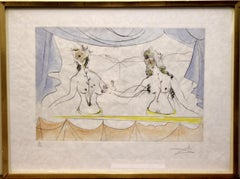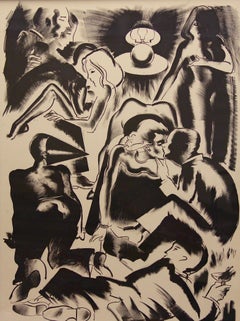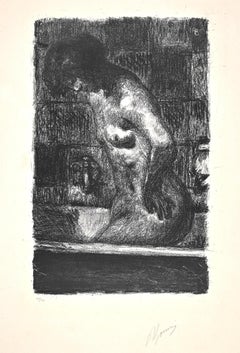Fine Art & Jewelry Nude Prints
to
2
2
Overall Width
to
Overall Height
to
1
1
1
1
2
1
1
1
1
1
1
1
1
2
2
Salvador Dalí, LES DAMES DE LA RENAISSANCE, 1971 Hand signed and numbered.
By Salvador Dalí
Located in Berlin, DE
Salvador Dalí, LES DAMES DE LA RENAISSANCE, 1971
Hand signed and numbered.
Etching on Japanese paper.
Signed "Dalí" lower right and numbered "21/120" left.
Dimensions are with fra...
Category
20th Century Abstract Abstract Prints
Materials
Etching
Allen Jones 1984 "High Society" Lithograph 43/45
By Allen Jones
Located in Berlin, DE
Original lithograph. Allen Jones "High Society".
From first owner. Numbered and signed.
Dimensions including original frame.
Category
1980s Modern Nude Prints
Materials
Lithograph
$3,826 Sale Price
20% Off
Related Items
Femme Debout dans sa Baignoire - Lithograph by Pierre Bonnard - 1920s
By Pierre Bonnard
Located in Roma, IT
Very rare edition of only 25 prints on vélin fort, numbered and signed by the artist. Redness on left side of the sheet, otherwise excellent conditions and in full margins.
Dry stamp...
Category
1920s Modern Nude Prints
Materials
Lithograph
$4,610
H 11.74 in W 7.6 in D 0.04 in
Female Nude - Lithograph by Nicolas Gloutchenko - 1928
By Nicolas Gloutchenko
Located in Roma, IT
Female nude is an original artwork realized by Nicolas Gloutchenko in 1928.
Lithograph on paper.
Hand-signed in pencil by the artist on the lower and numbered, edition of 8/12 prin...
Category
1920s Modern Figurative Prints
Materials
Lithograph
$334
H 14.97 in W 11.03 in D 0.04 in
Three Reclining Figures
By Henry Moore
Located in San Francisco, CA
Artist: Henry Moore (British, 1898-1986)
Title: Three Reclining Figures
Year: 1976
Medium: Color lithograph
Edition: 110
Paper: Arches
I...
Category
1970s Abstract Abstract Prints
Materials
Lithograph
Nude Woman with Tree - Original Lithograph by Jacques Busse - Mid 20th Century
By Jacques Busse
Located in Roma, IT
Nude woman with tree is an original artwork realized by French artist Jacques Busse (1922-2004)
Lithograph print.
Hand-signed on the lower right in pe...
Category
Mid-20th Century Modern Figurative Prints
Materials
Lithograph
$298
H 11.03 in W 14.97 in D 0.08 in
Dame Creole
By Henry Moore
Located in San Francisco, CA
Artist: Henry Moore (British, 1898-1986)
Title: Dame Creole
Year: 1976
Medium: Color lithograph
Edition: 110
Paper: Arches
Image size: 18.5 x 15 inches
paper size: 18.5 x 15 i...
Category
1970s Abstract Abstract Prints
Materials
Lithograph
Les Poetes, La Poesie, Front Page
By Henry Moore
Located in San Francisco, CA
Artist: Henry Moore (British, 1898-1986)
Title: Les Poetes, La Poesie, Front Page
Year: 1976
Medium: Color lithograph
Edition: 110
Paper: Arches
Paper...
Category
1970s Abstract Abstract Prints
Materials
Lithograph
Nude Model in Blue - Lithograph
By (after) Pablo Picasso
Located in Paris, IDF
Pablo PICASSO (after)
Nude Model in Blue, 1974
Lithograph
Unsigned
On Japan paper 39 x 28.5 cm (c. 15.4 x 11.2 inches)
INFORMATION : Lithograph based on drawings by Pablo Picasso, ...
Category
1970s Modern Nude Prints
Materials
Lithograph
La Source dans les Bois - Lithograph by Henri Fantin-Latour - 1898
By Henri Fantin-Latour
Located in Roma, IT
Autographie (Calcography on paper transfer and Lithograph).
Beautiful Proof in sanguine on China paper.
In Excellent conditions and full margins.
Ref. Cat. Hédiart-Mason n.139; Jo...
Category
1890s Modern Figurative Prints
Materials
Lithograph
$1,136
H 11.82 in W 16.62 in D 0.04 in
German Surrealist Hans Bellmer Etching Engraving Print Cecile Reims Surrealism
By Hans Bellmer
Located in Surfside, FL
After Hans Bellmer (German, 1902-1975)
Surrealist engraving, etching
after drawings from a 1942 notebook,
engraved in 1974-75 by Cecile Reims
Printed by L'Atelier de Chalcographie du Louvre, Paris,
Having printed monogram lower left in plate, pencil notations and #7/10 and 'Musee du Louvre' blindstamp verso
Dimensions: Sheet 11 X 7.5, Plate size 6.5 X 4
Hans Bellmer ( 1902 – 1975) was a Polish born German artist, best known for his drawings, etchings that illustrates the 1940 edition of Histoire de l’œil, and the life-sized female sculpture mannequin dolls he produced in the mid-1930s. Historians of art and photography also consider him a Surrealist photographer.
Bellmer was born in the city of Kattowitz, then part of the German Empire (now Katowice, Poland). Up until 1926, he worked as a draftsman for his own advertising company.
Bellmer is most famous for the creation of a series of dolls as well as photographs of them. He was influenced in his choice of art form in part by reading the published letters of Oskar Kokoschka (Der Fetisch, 1925) and Surrealism. Bellmer's puppet doll project is also said to have been catalysed by a series of events in his personal life.
Hans Bellmer takes credit for provoking a physical crisis in his father and brings his own artistic creativity into association with childhood insubordination and resentment toward a severe and humorless paternal authority. Perhaps this is one reason for the nearly universal, unquestioning acceptance in the literature of Bellmer's promotion of his art as a struggle against his father, the police, and ultimately, fascism and the state. Events of his personal life also including meeting a beautiful teenage cousin in 1932 (and perhaps other unattainable beauties), attending a performance of Jacques Offenbach's Tales of Hoffmann (in which a man falls tragically in love with an automaton), and receiving a box of his old toys. After these events, he began to actually construct his first dolls. In his works, Bellmer explicitly sexualized the doll as a young girl (his work bears connection to the works of Bathus). Hirschfeld has claimed (without further argumentation) that Bellmer initiated his doll project to oppose the fascism of the Nazi Party by declaring that he would make no work that would support the new German state. Represented by mutated forms and unconventional poses, his dolls (according to this view) were directed specifically at the cult of the perfect body then prominent in Germany.
He visited Paris in 1935 and made contacts there, such as Paul Éluard, but returned to Berlin because his wife Margarete was dying of tuberculosis. He was part of the circle of Surrealist luminaries such as Man Ray, Marcel Duchamp, Max Ernst, Joan Miro, André Masson, René Magritte, Alberto Giacometti and Salvador Dali as well as women artists—such as Frida Kahlo, Dorothea Tanning and Leonora Carrington.
Bellmer produced the first doll in Berlin in 1933. Long since lost, the assemblage can nevertheless be correctly described thanks to approximately two dozen photographs Bellmer took at the time of its construction. Standing about fifty-six inches tall, the doll consisted of a modeled torso made of flax fiber, glue, and plaster; a mask-like head of the same material with glass eyes and a long, unkempt wig; and a pair of legs made from broomsticks or dowel rods. One of these legs terminated in a wooden, club-like foot; the other was encased in a more naturalistic plaster shell, jointed at the knee and ankle. As the project progressed, Bellmer made a second set of hollow plaster legs, with wooden ball joints for the doll's hips and knees. There were no arms to the first sculpture, but Bellmer did fashion or find a single wooden hand, which appears among the assortment of doll parts the artist documented in an untitled photograph of 1934, as well as in several photographs of later work.
Bellmer's 1934 anonymous book, The Doll (Die Puppe), produced and published privately in Germany, contains 10 black-and-white photographs of Bellmer's first doll arranged in a series of "tableaux vivants" (living pictures). The book was not credited to him, as he worked in isolation, and his photographs remained almost unknown in Germany. Yet Bellmer's work was eventually declared "degenerate" (entartete kunst) by the Nazi Party, and he was forced to flee Germany to France in 1938, where Bellmer's work was welcomed by the Surrealists around Andre Breton.
He aided the French Resistance during the war by making fake passports. He was imprisoned in the Camp des Milles prison at Aix-en-Provence, a brickworks camp for German nationals, from September 1939 until the end of the Phoney War in May 1940.
After the war, Bellmer lived the rest of his life in Paris. Bellmer gave up doll-making and spent the following decades creating erotic drawings, etchings, sexually explicit photographs, paintings, and prints of pubescent girls. In 1954, he met Unica Zürn...
Category
20th Century Abstract Prints
Materials
Etching
Pastorales
By Ker Xavier Roussel
Located in Roma, IT
Fine lithograph on ivory colored China paper. Signature on plate on the lower right margin. Beautiful artwork representing a bucolic scene.Excellent conditions, including cardboard p...
Category
1920s Modern Landscape Prints
Materials
Lithograph
'Environment & Evolution'
By Alexander Calder
Located in New York, NY
Alexander Calder’s 'Environment and Evolution' lithograph exemplifies his signature style of dynamic abstraction, translating the movement and balance of his famous mobiles into a tw...
Category
1970s Abstract Geometric Abstract Prints
Materials
Lithograph
German Surrealist Hans Bellmer Etching Engraving Print Cecile Reims Surrealism
By Hans Bellmer
Located in Surfside, FL
After Hans Bellmer (German, 1902-1975)
Surrealist engraving, etching
after drawings from a 1942 notebook,
engraved in 1974-75 by Cecile Reims
Printed by L'Atelier de Chalcographie du Louvre, Paris,
Having printed monogram lower left in plate, pencil notations verso Editioned from a very small edition of #7/10
'Musee du Louvre' blindstamp.
Dimensions: Sheet 11 X 7.5, Plate size 6.5 X 4
Hans Bellmer ( 1902 – 1975) was a Polish born German artist, best known for his drawings, etchings that illustrates the 1940 edition of Histoire de l’œil, and the life-sized female sculpture mannequin dolls he produced in the mid-1930s. Historians of art and photography also consider him a Surrealist photographer.
Bellmer was born in the city of Kattowitz, then part of the German Empire (now Katowice, Poland). Up until 1926, he worked as a draftsman for his own advertising company.
Bellmer is most famous for the creation of a series of dolls as well as photographs of them. He was influenced in his choice of art form in part by reading the published letters of Oskar Kokoschka (Der Fetisch, 1925) and Surrealism. Bellmer's puppet doll project is also said to have been catalysed by a series of events in his personal life.
Hans Bellmer takes credit for provoking a physical crisis in his father and brings his own artistic creativity into association with childhood insubordination and resentment toward a severe and humorless paternal authority. Perhaps this is one reason for the nearly universal, unquestioning acceptance in the literature of Bellmer's promotion of his art as a struggle against his father, the police, and ultimately, fascism and the state. Events of his personal life also including meeting a beautiful teenage cousin in 1932 (and perhaps other unattainable beauties), attending a performance of Jacques Offenbach's Tales of Hoffmann (in which a man falls tragically in love with an automaton), and receiving a box of his old toys. After these events, he began to actually construct his first dolls. In his works, Bellmer explicitly sexualized the doll as a young girl (his work bears connection to the works of Bathus). Hirschfeld has claimed (without further argumentation) that Bellmer initiated his doll project to oppose the fascism of the Nazi Party by declaring that he would make no work that would support the new German state. Represented by mutated forms and unconventional poses, his dolls (according to this view) were directed specifically at the cult of the perfect body then prominent in Germany.
He visited Paris in 1935 and made contacts there, such as Paul Éluard, but returned to Berlin because his wife Margarete was dying of tuberculosis. He was part of the circle of Surrealist luminaries such as Man Ray, Marcel Duchamp, Max Ernst, Joan Miro, André Masson, René Magritte, Alberto Giacometti and Salvador Dali as well as women artists—such as Frida Kahlo, Dorothea Tanning and Leonora Carrington.
Bellmer produced the first doll in Berlin in 1933. Long since lost, the assemblage can nevertheless be correctly described thanks to approximately two dozen photographs Bellmer took at the time of its construction. Standing about fifty-six inches tall, the doll consisted of a modeled torso made of flax fiber, glue, and plaster; a mask-like head of the same material with glass eyes and a long, unkempt wig; and a pair of legs made from broomsticks or dowel rods. One of these legs terminated in a wooden, club-like foot; the other was encased in a more naturalistic plaster shell, jointed at the knee and ankle. As the project progressed, Bellmer made a second set of hollow plaster legs, with wooden ball joints for the doll's hips and knees. There were no arms to the first sculpture, but Bellmer did fashion or find a single wooden hand, which appears among the assortment of doll parts the artist documented in an untitled photograph of 1934, as well as in several photographs of later work.
Bellmer's 1934 anonymous book, The Doll (Die Puppe), produced and published privately in Germany, contains 10 black-and-white photographs of Bellmer's first doll arranged in a series of "tableaux vivants" (living pictures). The book was not credited to him, as he worked in isolation, and his photographs remained almost unknown in Germany. Yet Bellmer's work was eventually declared "degenerate" (entartete kunst) by the Nazi Party, and he was forced to flee Germany to France in 1938, where Bellmer's work was welcomed by the Surrealists around Andre Breton.
He aided the French Resistance during the war by making fake passports. He was imprisoned in the Camp des Milles prison at Aix-en-Provence, a brickworks camp for German nationals, from September 1939 until the end of the Phoney War in May 1940.
After the war, Bellmer lived the rest of his life in Paris. Bellmer gave up doll-making and spent the following decades creating erotic drawings, etchings, sexually explicit photographs, paintings, and prints of pubescent girls. In 1954, he met Unica Zürn...
Category
20th Century Abstract Prints
Materials
Etching



